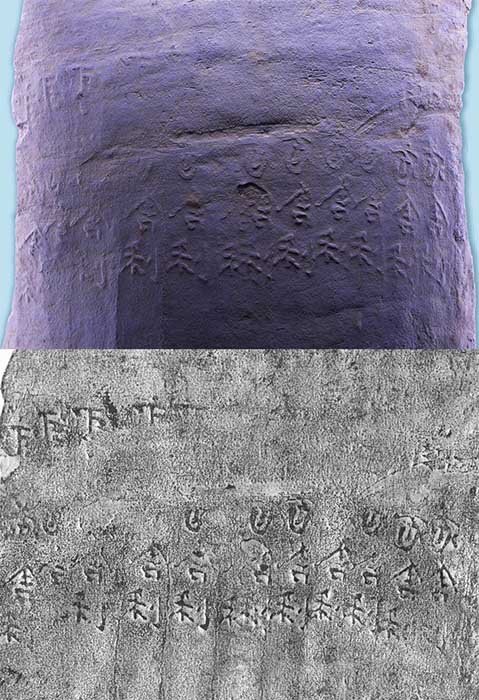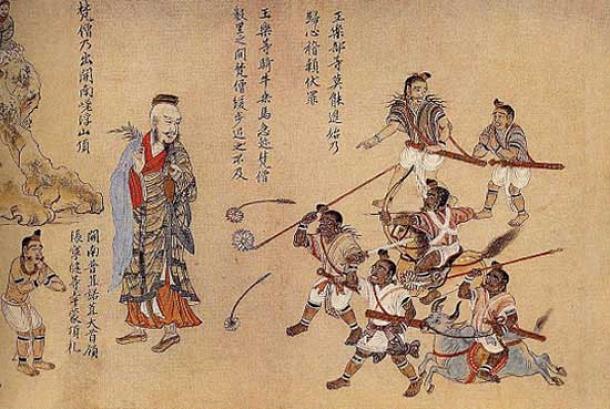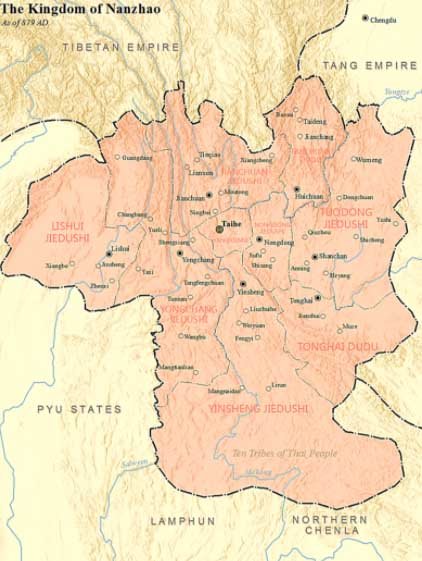Archaeologists have discovered an ancient temple complex dating back to a society once subjugated by the Tang Dynasty – the state of Nanzhao. Researchers found the words “Buddha sarira enshrined by the government” on a tile within the complex. According to the archaeologists, these words indicate that the site may be a royal religious site in which Buddhist relics of the Nanzhao royal court are enshrined and were worshiped inside the temple.
According to Xinhuanet, the lead researcher on the project, Zhu Zhonghua, discovered the ruins within the city of Dali in southwest China’s Yunnan Province. Zhu and his team conducted excavation work from January to July 2020. They uncovered 14 foundations for structures, 63 stone walls , 23 ditches, over 40 tons of tiles, and over 17,300 other relics 600 meters to the south of Taihe. This finding will help archaeologists learn more about the temples built by the Nanzhao people, and their political and cultural center, Taihe.

Tile with the inscription ‘Buddha sarira enshrined by the government’. The inscription indicates that the temple might be a royal religious site of the State of Nanzhao. (Yunnan Provincial Research Institute of Cultural Relics and Archaeology / xinhuanet)
The word ‘sarira’ has several meanings, but in this context it is likely used to refer to the Buddhist’s cremated remains.
Who Were the Nanzhao
According to China Knowledge , the Nanzhao state initially consisted of the tribes of the Black Man and the White Man ( wuman and baiman) and existed from 649 to 902. By the end of the 6th century, the Black Man tribes became the largest, and their six chieftains were known as Liu Zhao, who ruled over six tribes known as the Mengshe.
In 649, a chieftain named Xinuluo became the Outstanding King and accepted the Tang Dynasty’s supremacy and provided them tribute. The tribe’s influence expanded under Xinuluo’s descendent, Piluoge, and his son Geluofeng. They expanded Yunnan north and west, minimizing the power of the Cuan family. Xinuluo’s expansion caused the Tang empire problems as they tried to establish influence in this southwestern region.

Extract of Nanzhao Tujuan scroll – the Nanzhao Buddhists are depicted as light skinned whereas the non-Buddhists are depicted as rebellious short brown people. ( Public Domain )
Conflict Between the Tang and King Geluofeng
The Tang aimed to make progress in the region by establishing a prefecture of Yaozhou and the city of Anning and tried to minimize the expansion and autonomy of the Mengshe kings. In retaliation, Geluofeng attacked Yaozhou and killed its governor in 750, ending the Nanzhao tributary to the Tang, He then allied with the king of Tubo of Tibet. Within a couple of years of this triumph, Geluofeng was given the title Eastern Emperor and was given the Tibetan empire’s official seal, becoming the “royal brother.”
Tang Loses Dominance in the Southwest and Nanzhao Expands
To subjugate Nanzhao, Yang Guozhong dispatched the Tang army but was defeated. A rebellion known as ‘An Lushan’ took the Tang empire by surprise, leaving them with no military strength in the southwestern borders. This conflict allowed for Nanzhao to expand north and east into what is known today as Sichuan and Guizhou. Between 780 – 808 AD, King Yimouxun helped the Nanzhao reach its most significant expansion, but it remained a vassal state under Tibet.
In 794, King Yimouxun grew tired of the military tribute relationship with Tibet and resumed vassalship with the Tang empire. In 829, the army of Nanzhao conquered Chengdu. The royal court of Nanzhao lost its steam toward the end of the 9th century, first when King Longshu was assassinated in 897 by a rebel named Yang Deng and then as a variety of successors usurped the throne and changed the name of the state.

Kingdom of Nanzhao as of 879 AD. (SY / CC BY-SA 4.0 )
Nanzhao has a long history of war and expansion, but it did manage to establish a strong society. It adopted many of the Chinese administrational systems, and many members of the aristocracy sought Chinese education. Their royal families also created works of poetry, which were included in a collection called the Quantangshi. Not only were they influenced by the Chinese culture, but the Nanzhao also influenced the Chinese. The Nanzhao court employed Chinese artisans and craftsmen. They taught skills such as the weaving of cotton and silk gauze. Buddhism was also very popular within the Nanzhao court, as evidenced by the Chongsheng Monastery and the three famous pagodas in Dali constructed during the Nanzhao period.
This incredible find by archaeologists provides insight into the cultural and religious nature of this society. Even though Nanzhao had humble beginnings, the findings show that it had reached a high level of culture and artistry. Not only this, it shows the extraordinary level of influence Chinese culture eventually had on the state even after it achieved its autonomy, especially in religion. Taihe, the region near where the remains were uncovered, was a robust political and cultural center for Nanzhao.
Top image: Photo taken on Jan.13, 2021 shows an ancient temple complex dating back to the State of Nanzhao, a slave society established during the Tang Dynasty (AD 618-907) in Dali, southwest China’s Yunnan Province. Source: Yunnan Provincial Research Institute of Cultural Relics and Archaeology / xinhuanet
By ML Childs
Related posts:
Views: 0
 RSS Feed
RSS Feed
















 January 23rd, 2021
January 23rd, 2021  Awake Goy
Awake Goy  Posted in
Posted in  Tags:
Tags: 
















